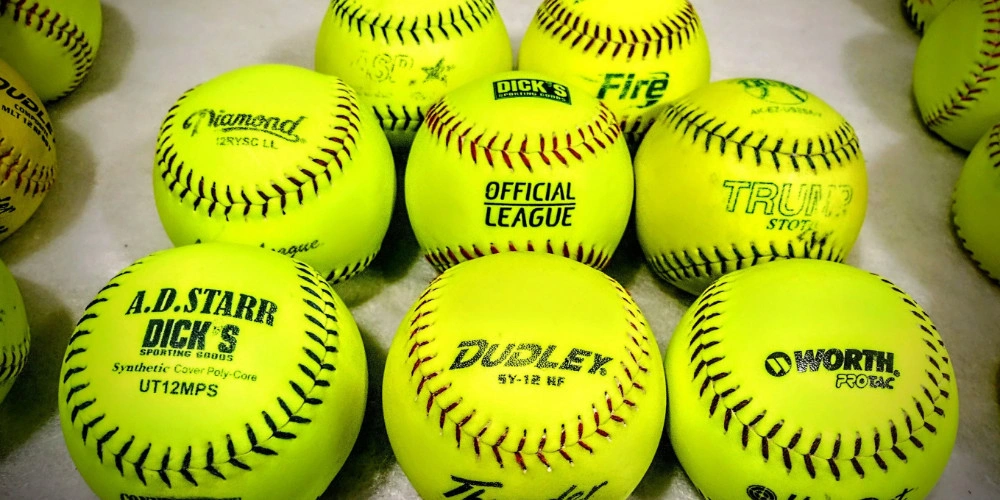Everything You Need to Know About Softballs
When it comes to softball, there’s a lot of conversation around bats and gloves. Parents, athletes and coaches want to know everything there is to know about the latest and greatest pieces of equipment.
But do you know what doesn’t get enough attention?
Talk about the softball itself.
Admittedly, I got into fastpitch softball very late (15), and when I made the switch from slowpitch to fastpitch, I had no idea the ball was different.
Then, I went to college and AGAIN was blown away by the fact that the ball was different.
Call me naive, but if the ball could be hit, thrown or fielded, I didn’t really pay attention to the differences.
Today as a coach and club director, I cannot stress enough the importance of knowing and using the appropriate ball for your sport and age group.
Let’s start with the basics.
What Are Softballs Made Of?
While a softball may vary across age groups and sport, all softballs have 3 components - the core, the cover and the seams.
The core is the innermost part of the ball. It is most often made from polyurethane, but can sometimes be found to have a cork center. In comparison, a baseball is made with a cushioned cork center wrapped by a cotton-like yarn.
The cover is where you’ll find a great deal of variation across manufacturers. They use leather, synthetic materials or rubber that is glued or cemented to the core. Again, by comparison, baseball features game balls with cowhide leather and practice balls of rubber or synthetic material.
Finally, the seams or laces. The seams hold the two figure-8 shaped pieces of the cover together. Seams most often colored blue, red or white, and the size is where you’ll see the most difference between fastpitch and slowpitch.
How Do Fastpitch and Slowpitch Balls Differ?
Speaking of those differences in seams, let’s take a look at how fastpitch and slowpitch softballs differ.
1. Seam Height - Fastpitch softball features raised seams to allow for better grip, control and movement on the ball. On the other hand, slowpitch softballs feature a minimalist seam to allow for maximum velocity and speed off the bat.
2. Core - Fastpitch softball requires a high-compression softball (further explained below), where a slowpitch league may require a ball with less compression. Aside from this, the internal makeup remains similar between fastpitch and slowpitch.
3. Color - Fastpitch only uses neon yellow softballs; however, in slowpitch you might see a white ball. While it is league dependent, the neon yellow softballs are reserved for high-level tournament play and white softballs are used in other styles of competition.
4. Size - It’s most common to see softballs range from 10 to 12” in both slowpitch and fastpitch, but there are slowpitch leagues that use 16” softballs. The most common size of fastpitch softball is the 11” ball (more on age variation below), which allows the ball to travel at higher speeds. The most common size of slowpitch softball is the 12” ball, which suits the slower speeds.
How Are Softballs Regulated?
What you might not realize is that softballs must meet certain guidelines and regulations in order to be legal for competition.
There are two specific regulations a ball must adhere to in order to be legal for use:
1. Compression Rating - This looks at the hardness or stiffness of a ball. Compression testing specifically looks at how much force it takes to compress the ball one quarter of an inch. The “best” and most popular compression ratings are 400 or 450 pounds.
2. COR Value - COR or Coefficient of Restitution looks at the “bounciness” of the ball. Softballs undergo testing to receive a COR value, wherein they collide with an immovable object to determine how much energy is given back or left after contact. Softballs with a high COR rating are more likely to bounce off any hard surface and lead to a higher exit velocity and distance; however, softballs with a high COR typically have a lower compression rating. The most common and widely accepted COR ratings are 44 and 47.
How Do Softballs Differ for Age Groups?
COR and compression ratings are not the only way softballs change, as many leagues require different size softballs for different age groups.
10U/Youth
This age division typically features a 10” ball (some leagues will call for an 11” ball in slowpitch) with a softer core. The purpose of the smaller ball is to accommodate smaller hands and better grip.
12U to 18U/High School
At this age, fastpitch players are asked to use an 11” ball and slowpitch players are asked to use a 12” ball. Leagues vary seam height and COR/compression rating to accommodate age group and level of play.
Collegiate Play
Here you’re competing with the best, and while you’re still using an 11” fastpitch softball, there are differences in the seams and COR/compression rating. Seams tend to be more pronounced for improved grip, and COR/compression is standard to 47/400.
Are There Better Balls for Different Conditions?
As an athlete at any level you’re going to experience adverse playing conditions.
Some days might be too hot, while others are freezing cold.
Some days might be dry, while others, wet and rainy.
A commonly asked question by athletes is if the type of ball matters in differing weather conditions.
In short, no.
Mostly because the regulations are still dependent on the league and softballs cannot often be interchanged based on weather conditions.
That doesn’t mean certain softballs aren’t advantageous in certain conditions.
For example, wet, rainy conditions would benefit from a higher seamed ball. This will allow for better grip on a slippery ball.
Another example comes in warm weather. A ball with a higher COR/compression rating can prove to have a bit more “pop” on contact due to the warmer conditions.
In my opinion, practice with a variety of softballs in a variety of simulated conditions so you’re prepared to handle anything!
Can You Use Softballs in Pitching Machines?
When I was a youth player, it was a sin to put a softball through a pitching machine, but machines have advanced so much where some will use specific types of softballs.
These softballs MUST have a low seam and a lower COR/compression rating.
Machine balls are dimpled, seamless, and made of a hard rubber material. These balls were designed without seams to keep batters safe as to prevent catching on the machine.
It should be known that every machine manufacturer recommends the use of machine balls over the use of traditional softballs. Not only is it safer for the hitter and feeder, traditional softballs are not designed to handle the wear and tear created by the machine.
Didn’t know there was so much to softball, did you?
At one point, neither did I!
But knowledge around what softballs you’ll be using can simplify the decision making process when looking at new bats and gloves!

